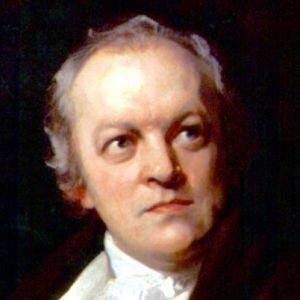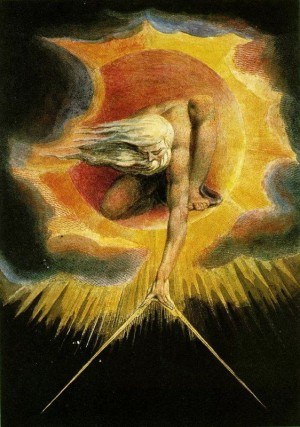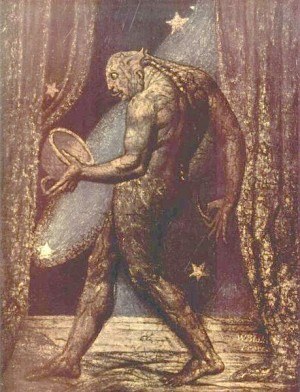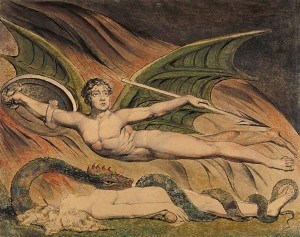William Blake (1757-1827) was one of the strangest and most difficult to categorize of eighteenth century British literary figures. We are not even sure that “literary figure” correctly describes him, since it was as an illustrator that he primarily earned his bread.
His early life
He came from humble origins as the son of a London hosier. From early youth he was haunted by religious and demonic visions. He claimed to have seen angels, gods, and spirits beginning at the age of four, and thereafter enjoyed a close association with the supernatural.
As a child he was withdrawn and moody, and lived in a world of his own sensations. At the age of ten, he attended a school for illustrators in the Strand; this was followed by an extended apprenticeship with an engraver. All this time he immersed himself in Romantic poetry, from which he acquired a taste for exotic themes and lush, gothic settings.
It was not long before he began to take up the pen. Unique in the annals of poetry, he illustrated his own written verses with as much ability as he wrote them. His illustrated poems thus comprise a self-contained world, in which the reader finds himself immersed entirely in Blake’s dreamscapes.
He tried to attend the Royal Academy at the age of twenty-five, but was rejected for lack of sufficient academic credentials. How old is the story of genius spurned by the establishment!
Marriage discovered him at the age of twenty-five as well. His wife, Catherine Boucher, tolerated him about as much any woman could under the circumstances; but moody, visionary geniuses do not often make for good bedfellows. But he was no prude; in fact, he condemned sexual abstinence as a mark of ignorance and repression.
And yet he must have had some redeeming human qualities, for in 1783 two moneyed well-wishers financed the private printing of a volume of his verses named Poetical Sketches. Here was first displayed the main themes of his work: moody mysticism, individuality, and a fiery religious fervor.
An innovator as well
One of the main factors in preventing Blake’s work from reaching a large audience was the financial cost of printing his books: they required both engraved plates as well as regular typescript, as he insisted on illustrating his own volumes.
Inexpensive editions of his works were hard to generate with the printing technology of the day, and so the circulation of his books remained low. Art to him could never be compromised. He would later, however, invent a process of engraving both text and illustrations on the same plate.
By 1784 he had sufficient means to open his own print shop on Broad Street in London. His brother Robert gave him valuable assistance in the beginning, but perished from tuberculosis in 1787.
The year 1789 saw the publication of Songs of Innocence, which was tinged by religious themes. This was followed in 1794 with Songs of Experience, which contains a personal favorite of mine. An excerpt below gives us a taste of his mystical tendencies:
Tyger, Tyger, burning bright
In the forests of the night,
What immortal hand or eye
Could frame they fearful symmetry?…
And what shoulder, and what art,
Could twist the sinews of thy heart?
And when thy heart began to beat,
What dread hands and what dread feet?
He was an idealist at heart, and believed in the brotherhood of man; the failure of the French Revolution to produce a utopia was a crushing disappointment to him. He was darkly suspicious of science, as he believed it to be a corrupter of faith, as well as an artifice used to oppress the common man.
After 1815 he gradually drifted away from poetry, probably finding that it did little to fatten his purse. His bread and butter remained illustration. He won in 1819 a commission from a wealthy man named John Linnell to illustrate some passages in the Bible and Dante’s Divine Comedy.
While hard at work on this task, he was overtaken by death. By this time he had become an obscure figure, and his funeral passed without notice. For many years the precise location of his grave-site was not known; in 1957, finally, a bronze bust of Blake was erected at Westminster Abbey.
The essence of the man
He had been so far ahead of his time that his contemporaries had lost sight of him. He distrusted political reactionaries; despised slavery; and believed that the imagination above all must be cultivated as the beating heart of the creative process.
He reminds us vaguely of Blaise Pascal, with the frequency and intensity of his religious visions, and the perhaps untreated medical issues he may have suffered from. No one quite knew how to categorize him. For many years after his death, his work, like that of Herman Melville in the United States much later, remained forgotten.
The publication of a sympathetic biography of his life in 1863 by Alexander Gilchrist changed all this, and he eventually came to be seen as a key figure in the Romantic movement. His reputation has increased steadily since the twentieth century.
He remains a fascinating figure. No poet before or since has combined such mastery of words and images. His work seems surprisingly modern: the lines of poetry are usually short, the impact is powerful, and the images stay fixed in the mind.
He was an apostle of the imagination, and a testament to the consuming power of a visionary ideal.
Read More: What I Learned From The Exorcist




“When I tell any truth it is not for the sake of convincing those who do not know it but for the sake of defending those who do.”
Powerful article.
He saw this world as nothing more than a vegetable universe (a bit like Paul Dirac’s notion of our hot exhaust cosmos)…Sex with women was also a way to the divine for him. His view on the two different forms of female is very powerful I think- Innocent (eve) and evil (the all destroying unconscious whore) are very true. The male types- like Albion (Reason), cold and dead, and Los (Imagination). There is a large part of the male psyche (creative/inventive) that resonates with his ideas, however, a lot of his ideas were bastardized by the hippies and flower power generation. His central message is don’t become a mere vegetable- use your gifts, your strength, your imagination.
So basically
Cool article! “The Divine Image” is great…
To Mercy Pity Peace and Love,
All pray in their distress:
And to these virtues of delight
Return their thankfulness.
For Mercy Pity Peace and Love,
Is God our father dear:
And Mercy Pity Peace and Love,
Is Man his child and care.
For Mercy has a human heart
Pity, a human face:
And Love, the human form divine,
And Peace, the human dress.
Then every man of every clime,
That prays in his distress,
Prays to the human form divine
Love Mercy Pity Peace.
And all must love the human form,
In heathen, turk or jew.
Where Mercy, Love & Pity dwell,
There God is dwelling too
My favorite by far. .
The GARDEN of LOVE
I went to the Garden of Love.
And saw what I never had seen:
A Chapel was built in the midst,
Where I used to play on the green.
And the gates of this Chapel were shut,
And Thou shalt not. writ over the door;
So I turn’d to the Garden of Love,
That so many sweet flowers bore.
And I saw it was filled with graves,
And tomb-stones where flowers should be:
And Priests in black gowns, were walking their rounds,
And binding with briars, my joys & desires.
Reminds me so of Nietzsche.
i highly recommend his poem ‘a poison tree.’
actually the first two lines basically give you all of the advice you need:
‘I was angry with my friend: I told my wrath, my wrath did end.
I was angry with my foe: I told it not, my wrath did grow…’
in other words, allowing other people to negatively impact your life, your peace of mind etc, will only serve to drive YOU crazy! gotta forgive, let go, and move on!
Neil Peart from Rush was certainly influenced by William Blake.
Auguries of Innocence
BY WILLIAM BLAKE
To see a World in a Grain of Sand
And a Heaven in a Wild Flower
Hold Infinity in the palm of your hand
And Eternity in an hour
——————————————–
Virtuality
RUSH
I can save the universe in a grain of sand
I can hold the future in my virtual hand
Borges admired Blake very much and “The Tyger” was among his preferred poems
Jorge Luis Borges On William Blake
William Blake, on the contrary, remains not only outside the pseudo-classic school (to use the most elevated term), and that is the school represented by [Alexander] Pope, but he also remains outside the romantic movement. He is an individual poet, and if there is anything we can connect him to—for, as Rubén Darío said, there is no literary Adam—we would have to connect him to much more ancient traditions: to the Cathar heretics in the south of France, the Gnostics in Asia Minor and Alexandria in the first century after Christ, and of course to the great and visionary Swedish thinker,Emmanuel Swedenborg. Because Blake was an isolated individual, his contemporaries considered him a bit mad, and perhaps he was. He was a visionary—as Swedenborg had been, of course—and his works circulated very little during his lifetime. Moreover, he was better known as an engraver and a draftsman than as a writer…. Blake’s work is extraordinarily difficult to read because he created a theological system. In order to express it, he had the idea of inventing a mythology, and critics don’t agree on what it means. There is a poem by Blake—it is included in all the anthologies—where this problem is expressed, but of course is not resolved…. In Songs of Experience, Blake deals directly with the problem of evil, and he symbolizes it, in the manner of the bestiaries of the Middle Ages, as a tiger. The poem, which consists of five or six stanzas, is called “The Tyger,” and was illustrated by the author.
O for a voice like thunder, and a tongue
To drown the throat of war! When the senses
Are shaken, and the soul is driven to madness,
Who can stand? When the souls of the oppressed
Fight in the troubled air that rages, who can stand?
When the whirlwind of fury comes from the
Throne of God, when the frowns of his countenance
Drive the nations together, who can stand?
When Sin claps his broad wings over the battle,
And sails rejoicing in the flood of Death;
When souls are torn to everlasting fire,
And fiends of Hell rejoice upon the slain,
O who can stand? O who hath causèd this?
O who can answer at the throne of God?
The Kings and Nobles of the Land have done it!
Hear it not, Heaven, thy Ministers have done it!
Stewart Lee agrees. He hasn’t read the latest Harry Potter, but he has read the Complete Works of William Blake.
What was his theology? What did he “see”?
And did those feet in ancient time
Walk upon England’s mountains green:
And was the holy Lamb of God,
On England’s pleasant pastures seen!
And did the Countenance Divine,
Shine forth upon our clouded hills?
And was Jerusalem builded here,
Among these dark Satanic Mills?
Bring me my Bow of burning gold;
Bring me my Arrows of desire:
Bring me my Spear: O clouds unfold!
Bring me my Chariot of fire!
I will not cease from Mental Fight,
Nor shall my Sword sleep in my hand:
Till we have built Jerusalem,
In England’s green & pleasant Land.
I Fucking hate poetry , what is he saying , what does it mean !
Thanks for this insight to my favorite poet, I did not know his history and the art side. And thanks to all for posting your favorite lines in the comments.
What happened to the article itself??